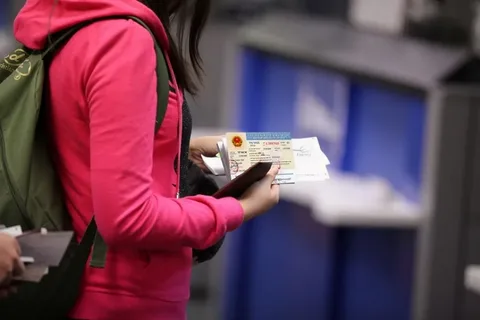Navigating Love Across Borders: A Comprehensive Review of the K-1 Fiancé Visa Process
varsha August 7, 2023 0 COMMENTS
In an increasingly interconnected world, the boundaries of love and relationships often transcend geographical limitations. The K-1 Fiancé Visa, colloquially known as the “fiancé visa,” has emerged as a critical pathway for couples separated by international borders to reunite and begin their journey towards marital bliss. This review article aims to provide a thorough analysis of the K-1 Fiancé Visa process, highlighting its significance, requirements, benefits, challenges, and overall impact on cross-border relationships.
Table of Contents
The K-1 Fiancé Visa: An Overview
The K-1 Fiance Visa is a nonimmigrant visa that permits a foreign fiancé(e) of a U.S. citizen to enter the United States with the intention of getting married within 90 days of arrival. The visa offers a unique opportunity for couples to live together and establish their relationship on American soil while preparing for the next step in their journey – marriage. Often referred to as the “love visa,” the K-1 visa acknowledges the importance of relationships that transcend national boundaries.
Requirements and Application Process
Securing a K-1 Fiancé Visa involves a rigorous process that demands meticulous attention to detail. The application process is initiated by the U.S. citizen petitioner, who must prove their intent to marry their foreign fiancé(e) within the stipulated timeframe. The primary requirements include demonstrating the legitimacy of the relationship, both parties being legally free to marry, and meeting the income threshold to ensure financial stability for the foreign fiancé(e).
The documentation process involves submitting evidence of the relationship, such as photographs, correspondence, and shared experiences, to establish its authenticity. Additionally, the U.S. citizen petitioner must submit an Affidavit of Support, demonstrating their financial capability to support the foreign fiancé(e) once they arrive in the United States. The rigorous background checks and medical examinations also form integral components of the visa process, ensuring the health and security of both parties.
Benefits of the K-1 Fiancé Visa
The K-1 Fiancé Visa offers several advantages that contribute to its popularity among cross-border couples:
- Reunification: The visa expedites the reunification of couples who would otherwise be separated by immigration barriers, allowing them to live together in the U.S. as they prepare for marriage.
- Path to Marriage: The K-1 visa recognizes the inherent desire of couples to formalize their relationship through marriage. It offers a unique opportunity for couples to plan their wedding in the United States.
- Exploration of Compatibility: By living together for the 90-day period, couples can experience day-to-day life and determine their compatibility before making the lifelong commitment of marriage.
- Legal Entry: The K-1 visa provides a legal means for the foreign fiancé(e) to enter the U.S., eliminating the stress and uncertainty associated with irregular methods of entry.
Challenges and Considerations
While the K-1 Fiancé Visa holds significant promise, it is not without its challenges and complexities:
- Stringent Requirements: The extensive documentation and evidence required to prove the authenticity of the relationship can be time-consuming and emotionally taxing.
- Financial Criteria: Meeting the income threshold outlined in the Affidavit of Support can be challenging, particularly if the U.S. citizen petitioner has an inconsistent income or is self-employed.
- Time Constraints: The 90-day window for marriage after the foreign fiancé(e) enters the U.S. can be stressful, as it demands careful planning and coordination.
- Cultural Adjustments: The foreign fiancé(e) may face cultural, social, and environmental adjustments upon arriving in the U.S., which can impact their overall experience.
- Uncertain Outcomes: Despite meeting all requirements, the final decision rests with U.S. Citizenship and Immigration Services (USCIS), leaving couples susceptible to potential denial of the visa.
The Impact on Relationships and Society
The K-1 Fiancé Visa has broader implications beyond individual relationships:
- Cultural Exchange: Cross-border relationships foster cultural exchange as partners share their customs, traditions, and perspectives.
- Social Integration: Successful integration of the foreign fiancé(e) into U.S. society enriches the multicultural fabric of the nation.
- Economic Contributions: Foreign fiancé(e)s who eventually become U.S. citizens contribute to the workforce, economy, and tax base.
- Legal Precedence: The K-1 visa sets a legal precedent by acknowledging the unique nature of international relationships and promoting family reunification.
Navigating the Visa Denial
Despite thorough preparations, there remains a possibility of visa denial. In such cases, couples have the option to reapply, but must address the specific concerns raised by USCIS. Seeking legal counsel can provide guidance on navigating the appeals process and addressing any potential issues.
Conclusion
The K-1 Fiancé Visa stands as a testament to the resilience of love that transcends borders. It symbolizes hope, commitment, and the power of relationships to bridge geographical divides. While the visa process can be arduous and demanding, its benefits often outweigh the challenges. The K-1 Fiancé Visa continues to play a vital role in facilitating the union of cross-border couples and enriching the cultural tapestry of nations, reminding us that love knows no boundaries.
RELATED ARTICLES
Latest Articles
 Unlocking Success: Mastering Bank PO Interview PreparationIn EducationApril 24, 2024For banking careers, PO interviews stand as formidable […]
Unlocking Success: Mastering Bank PO Interview PreparationIn EducationApril 24, 2024For banking careers, PO interviews stand as formidable […] The Strategic Value of Purchasing FontsIn TipsApril 18, 2024In today’s visually driven world, fonts are more […]
The Strategic Value of Purchasing FontsIn TipsApril 18, 2024In today’s visually driven world, fonts are more […] Revolutionizing Business: How AI Transforms Customer Experience in the Inflatable IndustryIn BusinessApril 16, 2024Inflatable water slides are the epitome of summer fun, […]
Revolutionizing Business: How AI Transforms Customer Experience in the Inflatable IndustryIn BusinessApril 16, 2024Inflatable water slides are the epitome of summer fun, […] Most Asked Microservice Interview Questions For 2024In TechnologyApril 2, 2024To keep up with changing trends in the tech industry […]
Most Asked Microservice Interview Questions For 2024In TechnologyApril 2, 2024To keep up with changing trends in the tech industry […] Best JavaScript and CSS Library In 2024In TechnologyApril 2, 2024With the ever-expanding functionality of web […]
Best JavaScript and CSS Library In 2024In TechnologyApril 2, 2024With the ever-expanding functionality of web […] Front-End Development Trends to Follow in 2024In TechnologyApril 2, 2024For better engagement, the front-end development of […]
Front-End Development Trends to Follow in 2024In TechnologyApril 2, 2024For better engagement, the front-end development of […] Simplifying Mealtime: Meal Prepping for a Family of FourIn UncategorizedMarch 22, 2024In the hustle and bustle of daily life, planning and […]
Simplifying Mealtime: Meal Prepping for a Family of FourIn UncategorizedMarch 22, 2024In the hustle and bustle of daily life, planning and […] How to Freeze Dry Candy With And Without a Machine?In FoodFebruary 27, 2024A candy lover constantly searches for novel and […]
How to Freeze Dry Candy With And Without a Machine?In FoodFebruary 27, 2024A candy lover constantly searches for novel and […] How to Get Something Out Of Your Eye Immediately?In healthFebruary 27, 2024Getting something inside your eyes can be frustrating […]
How to Get Something Out Of Your Eye Immediately?In healthFebruary 27, 2024Getting something inside your eyes can be frustrating […] The Evolution of Remote Control Technology: From RC Cars to DronesIn TechnologyFebruary 22, 2024Remote control technology has come a long way since […]
The Evolution of Remote Control Technology: From RC Cars to DronesIn TechnologyFebruary 22, 2024Remote control technology has come a long way since […] Unveiling the most popular carnival costumes: A colorful parade of creativityIn FashionFebruary 19, 2024In the world of festivities and merrymaking, few […]
Unveiling the most popular carnival costumes: A colorful parade of creativityIn FashionFebruary 19, 2024In the world of festivities and merrymaking, few […] Custom GPTs: The Next AI Opportunity for BusinessesIn Business, TechnologyFebruary 14, 2024The rise of artificial intelligence has transformed […]
Custom GPTs: The Next AI Opportunity for BusinessesIn Business, TechnologyFebruary 14, 2024The rise of artificial intelligence has transformed […]
stopie.com is a participant in the Amazon Services LLC Associates Program, an affiliate advertising program designed to provide a means for sites to earn advertising fees by advertising and linking to Amazon.com.
Clicking on an Amazon link from stopie.com does not increase the cost of any item you purchase.
We will only ever link to Amazon products that we think our visitors may be interested in and appreciate learning more about.



